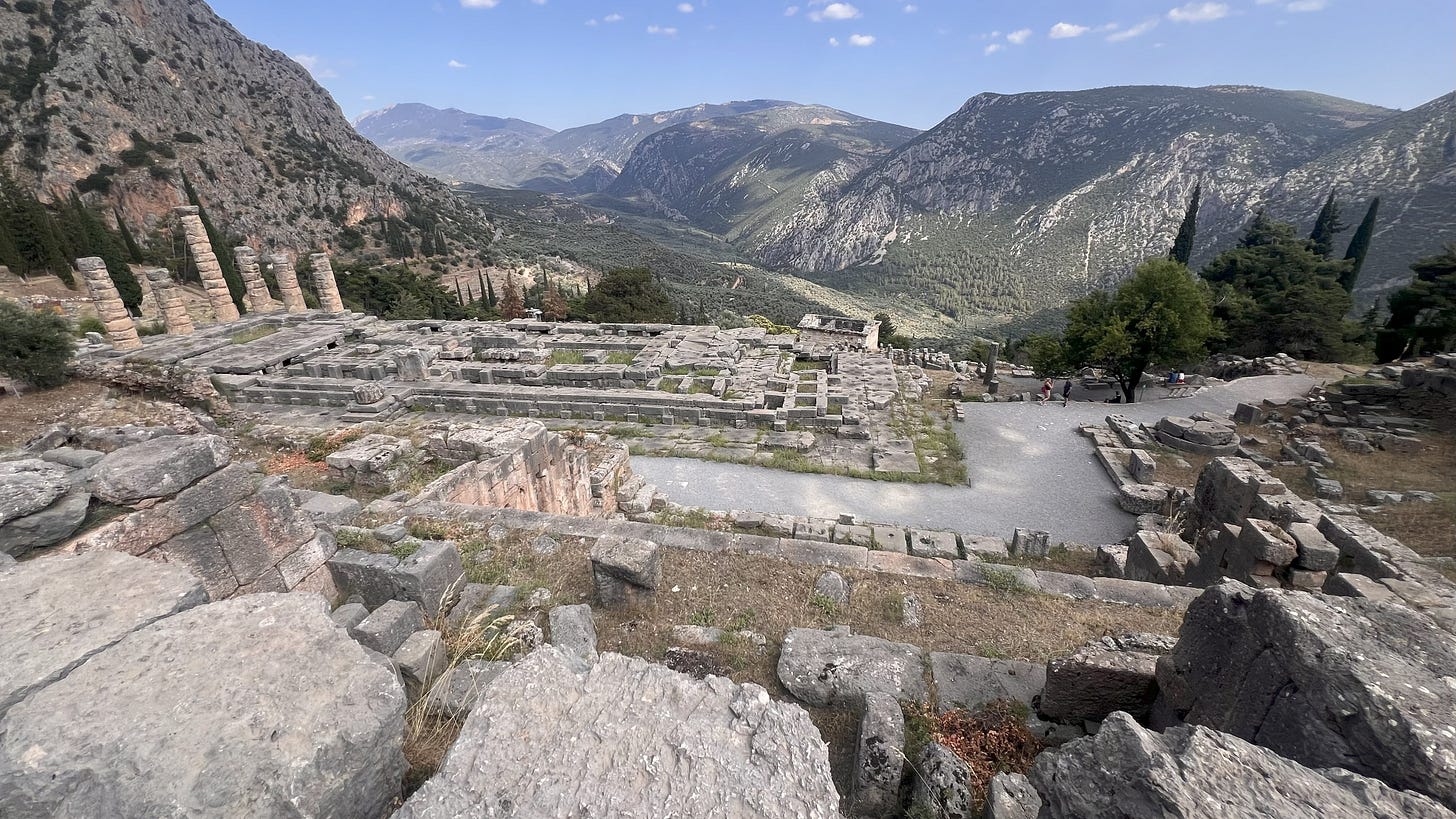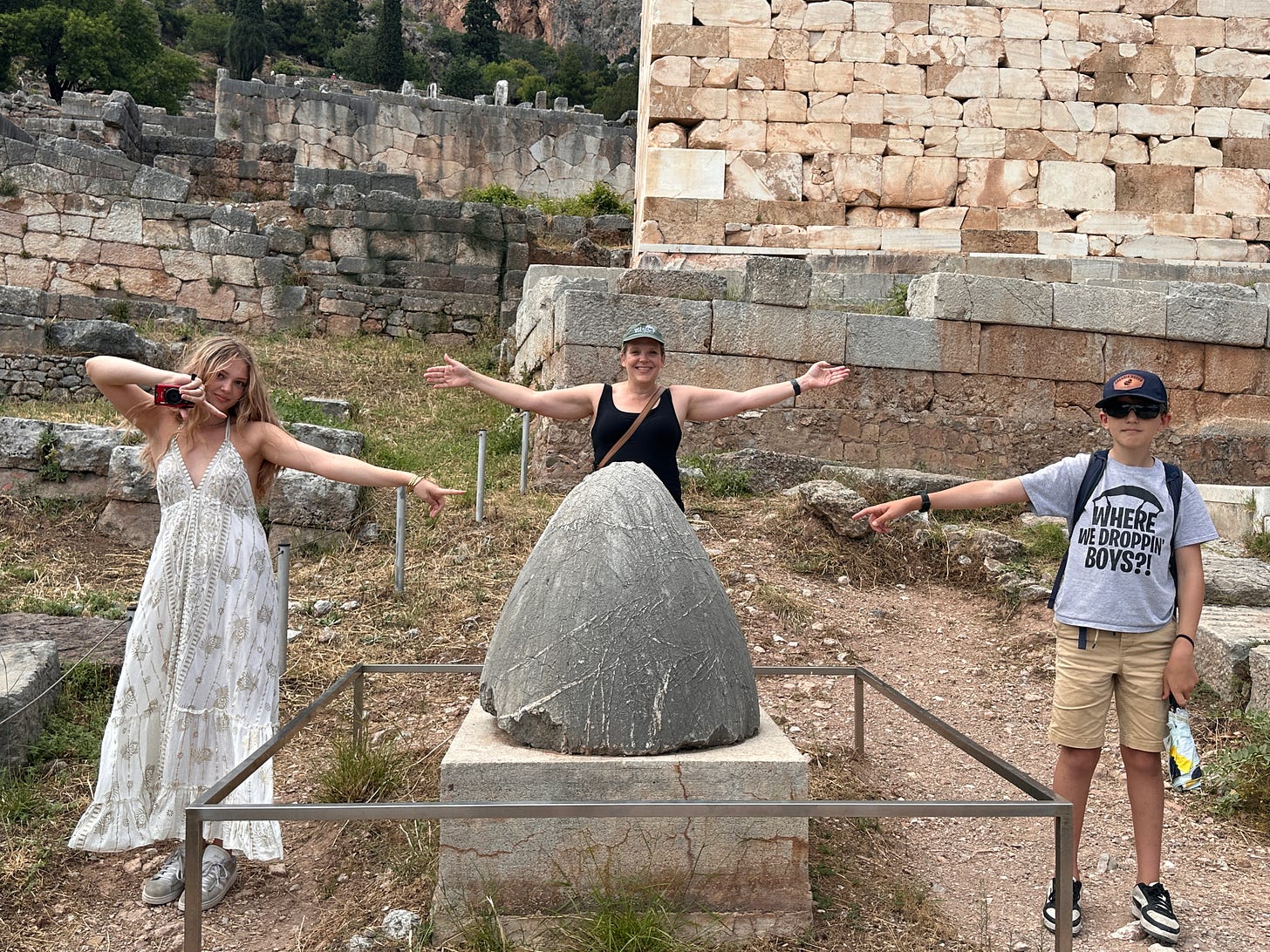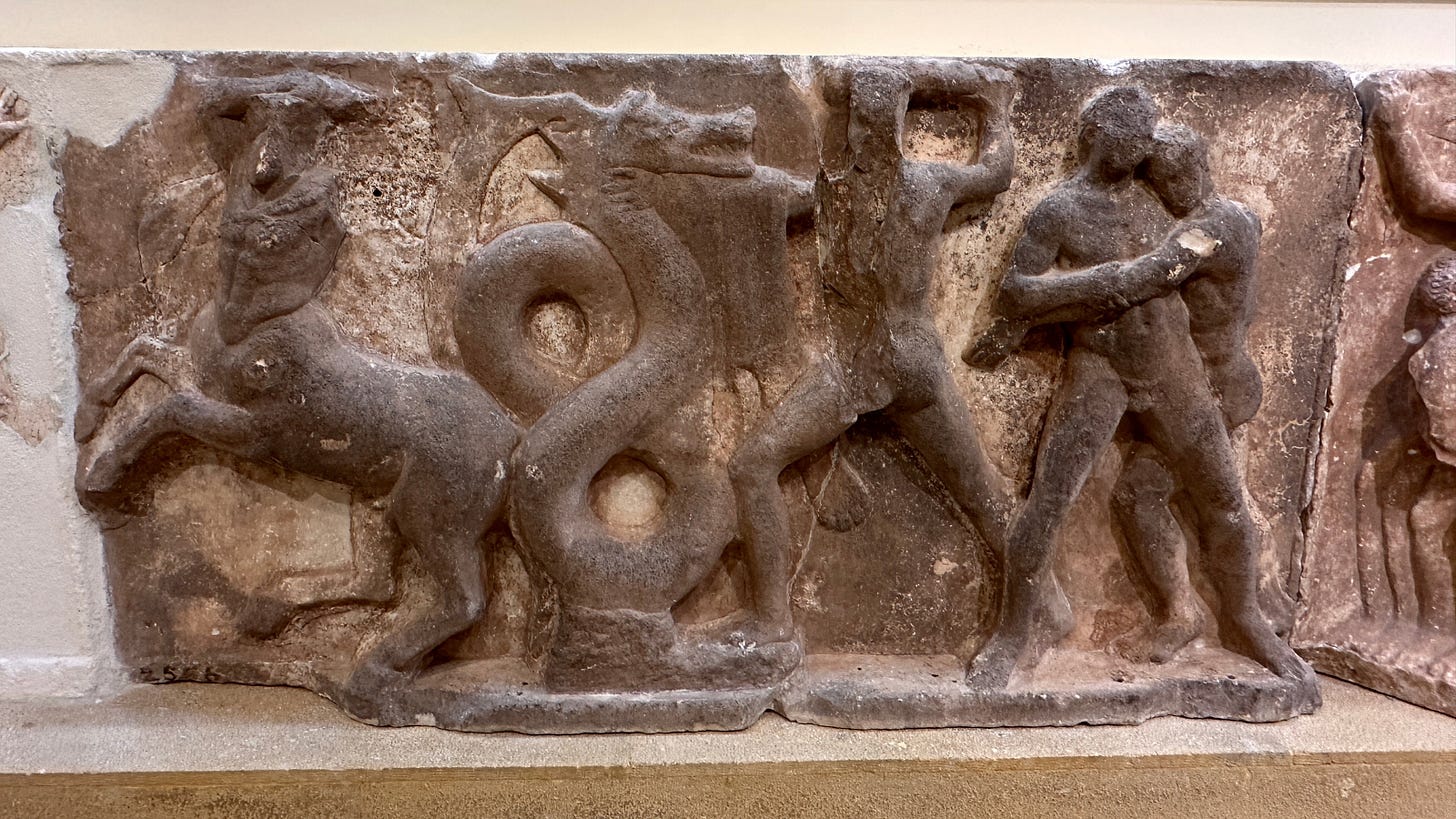
Good morning from the sunny city of Larissa, Greece! I’ve been invited here to speak at the University of Thessaly this evening as part of a celebration of their 25th anniversary of the Department of Biochemistry and Biotechnology! (More info on my events page.)
I’m here with my husband and two of our four kids. We made the drive yesterday from Athens to Larissa, skirting along the base of Mount Parnassus, where we stopped to visit the Delphi archeological site and museum.
This is our first trip to Greece. I’ve long been fascinated with Greek mythology and history, and couldn’t pass up the opportunity to visit the site where the famous Oracle of Delphi (actually represented by many different women over more than 1000 years!) shared visions with leaders of the ancient world, made possible by the inhalation of a noxious substance. Whether this substance was a mix of toxic gases emitted from cracks in the mountain or perhaps a toxic or hallucinogenic plant remains a mystery.
Delphi at the Center of the World

In ancient Greece, Delphi was considered the center of the world. As the legend goes, Zeus wanted to discover this central point, so he released two eagles from opposite ends of the earth (as it was known then)—one from the east and one from the west. The birds flew across the skies and eventually met over Delphi, identifying it as the earth's "omphalos," or navel. To mark the spot, a stone monument called the Omphalos was placed there (see pictures above), symbolizing Delphi’s importance as the spiritual and geographic heart of the ancient Greek world. The Omphalos was placed on top of a tall column adorned with three dancing women, located just a bit further down the hill where the Temple of Apollo was built.

In early Greek mythology, Delphi was originally a sacred site dedicated to Gaea, the Earth goddess. She was the first to offer prophetic insights through an oracle, known as the Sybil. Gaea’s son, Python, a serpent or dragon, guarded the sanctuary. The earliest prophecies were delivered through the Sybil (a female seer) upon the rock pictured below.

As the legend continues, eventually, Apollo, the god of prophecy, truth, archery, music, dance, healing and diseases came to claim the site for himself. He slew Gaea’s son Python and established his own oracle there. Afterward, the priestess of Apollo who delivered Apollo’s prophecies became known as the Pythia, a name that honored the slain serpent. This part of the story marks the transition of Delphi from an earth-centered cult to one centered on the Olympian god Apollo.

According to myth, after Apollo killed the serpent Python, he buried its body beneath the Temple of Apollo at Delphi. The site where Python was entombed was said to release mysterious vapors from a deep fissure in the earth. These vapors were believed to carry the lingering spirit or essence of Python. The Pythia, Apollo’s priestess, would inhale these fumes while seated on a tripod above the chasm, entering a trance-like state through which she delivered prophecies. Thus, Python’s buried body was directly linked to the oracle’s power, serving as a mythological explanation for the source of divine inspiration at Delphi.
Intersection of Modern Science & Prophecy
Geological research (see this research paper by de Boer, Hale and Chanton from 2001) demonstrated that Delphi lies at the junction of two major fault lines—the Delphi and Kerna faults—which run directly beneath the Temple of Apollo. These fractures in the earth's crust may have allowed light hydrocarbon gases to seep to the surface. Among them, ethylene has been identified as a likely source of the Pythia’s trance states (hence - the ethylene hypothesis). Ethylene is the same gas used in industrial agricultural production chains to force the ripening of fruit (e.g., turning green unripe tomatoes red). This sweet-smelling gas is mildly narcotic, and in low concentrations, it can induce euphoria, altered consciousness, and hallucinations—effects consistent with ancient descriptions of the oracle’s behavior. However, not all scholars agree with this hypothesis.
For example, this 2007 article by Lehoux argues that he ethylene gas hypothesis draws superficial parallels between the Pythia’s behavior and symptoms of mild anesthesia, such as rapid trance onset, altered speech, and amnesia. However, his analysis shows these comparisons are often vague, trivial, or unsupported by ancient sources. Moreover, symptoms typical of ethylene exposure, such as cyanosis or fatigue, are never mentioned in ancient accounts.
What about plants?
While some theories have suggested that the Pythia may have used psychoactive plants to enter her trance, there is little concrete evidence to support this. The bay laurel (Laurus nobilis), sacred to Apollo, was often chewed or held by the Pythia, but its mild sedative properties are unlikely to account for the intense visionary states described. Other potential botanicals like opium poppy, henbane, or datura have been proposed due to their hallucinogenic effects, yet there is no archaeological or textual evidence linking these to Delphic rituals. The use of nightshades like henbane has been hypothesized to be responsible for trancelike behaviors in other cultures, such as Bersekers (check out this 2021 podcast episode I recorded with Dr. Fatur on the Henbane Theory of Berserkers to learn more).
The Takeaway
Without the ability to step back in time, we may never fully understand the exact mechanism behind the trance-like states achieved by the Delphic seers over many centuries. While scientific theories—from fault-line gases like ethylene to ritual use of plants—offer intriguing possibilities, each has limitations. Ancient descriptions remain ambiguous, and the available archaeological evidence is inconclusive. What is clear, however, is that the Oracle of Delphi occupied a powerful role at the intersection of religion, nature, and culture. Whether the Sybil, and later, Pythia’s altered state was induced by natural gases, hallucinogenic plants, spiritual practice, or a combination of these, her voice shaped many decisions across the ancient world. The mystery endures and reminds us of the complex ways human beings have sought insight, meaning, and guidance from the natural world.
Yours in health, Dr. Quave
Cassandra L. Quave, Ph.D. is a Guggenheim Fellow, CNN Champion for Change, Fellow of the National Academy of Inventors, recipient of The National Academies Award for Excellence in Science Communication, and award-winning author of The Plant Hunter. Her day job is as professor and herbarium director at Emory University School of Medicine, where she leads a group of research scientists studying medicinal plants to find new life-saving drugs from nature. She hosts the Foodie Pharmacology podcast and writes the Nature’s Pharmacy newsletter to share the science behind natural medicines. To support her effort, consider a paid or founding subscription to Nature’s Pharmacy or donation to her lab research.
The Plant Hunter is available in hardcover, paperback, audio, and e-book formats!






